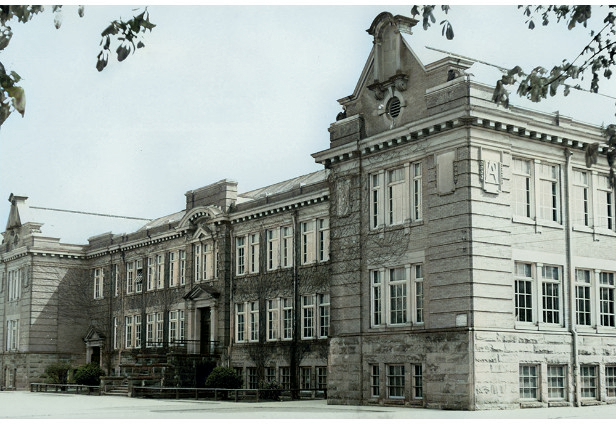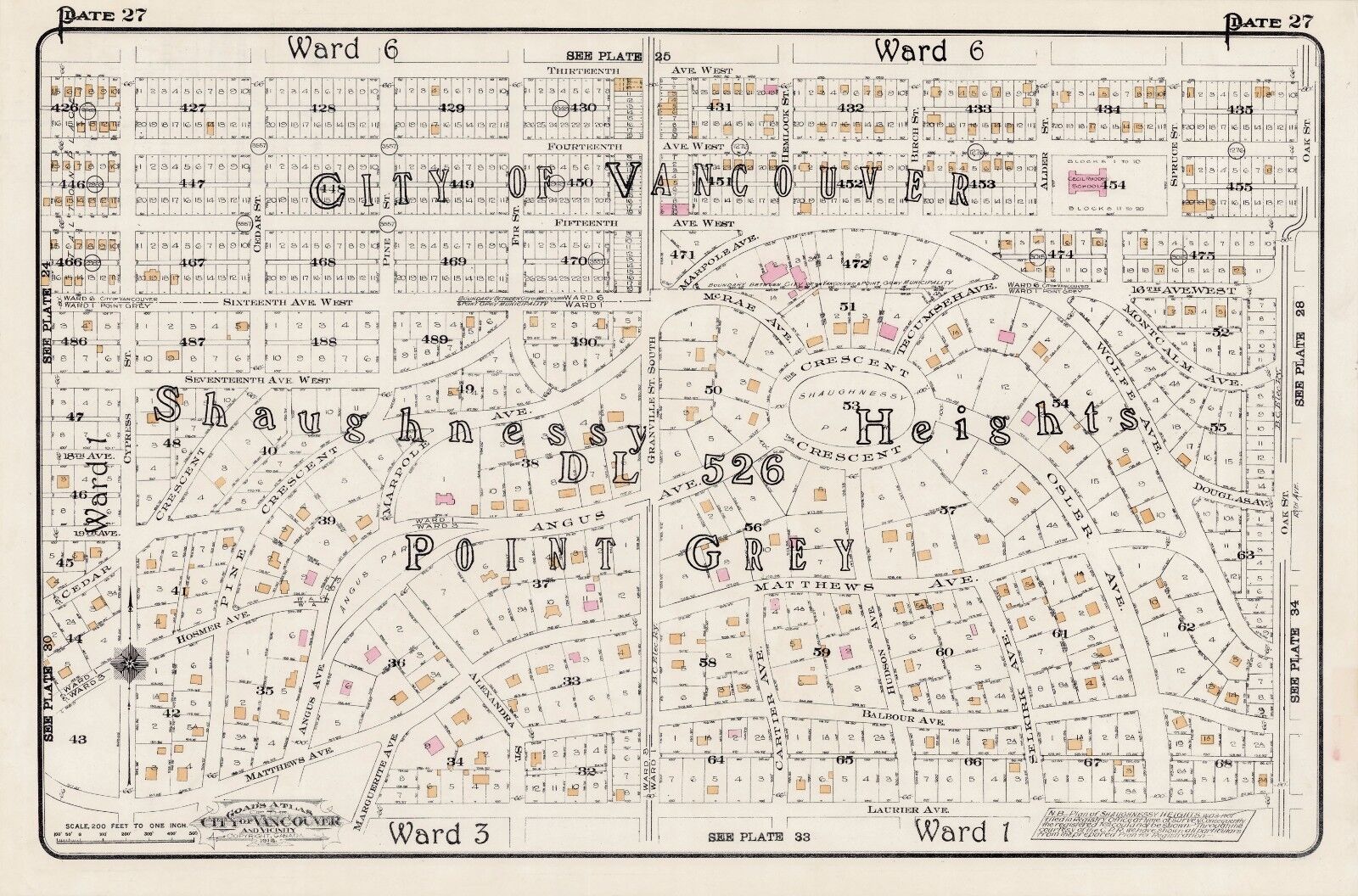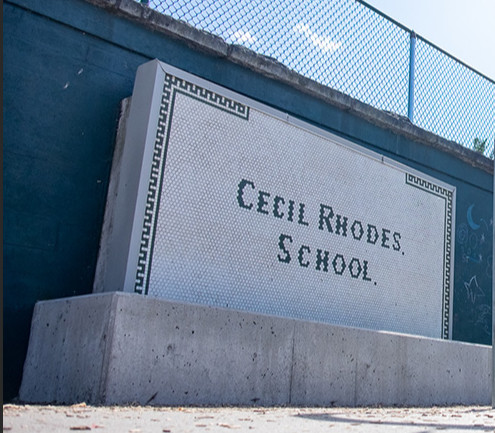 Cecil Rhodes
Cecil Rhodes

Cecil Rhodes School
Vancouver, BC, Canada


|
The Cecil Rhodes Public School building, known since 1977 as “L’Ecole Bilingue”. The building is located in Fairview, on 14th Avenue at Alder Street, and was designed by the Vancouver School Board architect Norman Leech in 1911-1912. Constructed with two classroom wings flanking a central core, it is a two-storey plus basement masonry building with prominent quoined corner pilasters. The school has generous fenestration, and its original wooden windows are in excellent condition. The main entrance is surmounted by an intricate glazed transom and its landing embodies its former name in mosaic. Chestnut trees and landscaping around L’Ecole Bilingue distinguish its property while contributing a tranquil urbanity to its immediate environment. Over the years, a number of its original features have been removed. Despite this loss of some architectural value, this neighbourhood landmark remains a reflection of its original panache and encapsulates several important pages of Vancouver’s history. L’Ecole Bilingue is listed in the “B” category on the Vancouver Heritage Register. L’Ecole Bilingue is just one of a number of historic schools that lost due to the Vancouver School Board’s seismic mitigation initiative. Significance Why is l’Ecole Bilingue (Cecil Rhodes) significant? This neighbourhood school had served its community for more than one hundred years and stood proud in the city, setting an example for its urbanity. It is important for its history, its architecture and its community landmark status. The school is associated with several trends in education: some classes were used for practice by the Normal School students; some high school classes took place in the building in 1917; it became the first commercial school in the City in 1918; and it became one of the first BC French language schools in 1977. Its original Beaux-Arts architecture was designed by Norman Austin Leech (1880-1945). He was Chief Architect for the Board of Education and designed nearly 20 school buildings for the Board from 1910 to 1914. In addition to Cecil Rhodes, his projects included General Gordon, Lord Nelson and Lord Tennyson public schools, Britannia High School and Sir James Douglas School. Leech was born in Winburg, South Africa and was educated at King’s College, University of London where he received the Gold Medal for architecture in his final year. He lectured at the Technical Institute at Norwich, England, then returned to South Africa and practised in Johannesburg in 1902-06. Leech immigrated to Canada in 1906 and settled in Vancouver where he focused on the design of local schools. The building was estimated 10 points out of 10 for its architectural value in the 2007 Commonwealth Report commissioned by the Vancouver School Board. The report states that the original building is an example of a school with restrained classical features and a ‘barbell’ plan. Most of Leech’s schools were executed in the Edwardian style, and constructed of brick cladding in a formally composed symmetrical plan that allowed for easy expansion. Its construction is associated with the tremendous expansion of Vancouver before World War I. Like many schools built at the time, it was constructed in two consecutive stages that reflected Vancouver’s rapidly-growing population. At the time, Fairview was a family neighbourhood and Cecil Rhodes Elementary was the school that provided many of the local kids a stepping stone to remarkable lives here and abroad; graduates from the school included Chief Justice of the Supreme Court of British Columbia, UBC Chancellor Nathan Nemetz, Vancouver Symphony and Osaka Philharmonic Concert Master Gerald Jarvis and beloved Vancouver Sun columnist Denny Boyd amongst others. L’Ecole Bilingue opened in September 1973 in David Lloyd George Annex. L’Ecole was designated a separate school in 1976, and moved to Cecil Rhodes in 1977. L’Ecole Bilingue contributed greatly to the promotion of the French language in BC, which helped fuel, the popular enthusiasm for a French education in Vancouver. L’Ecole Bilingue is also valued because of its role in the community. The participation in the “Greening of BC School Grounds” in 1995 by students, staff and parents of l’Ecole Bilingue is evidence of the school’s contribution to the improvement of the city environment. The landscape around l’Ecole Bilingue is a reminder of the collective effort and testifies to the vitality of the school. Position Heritage Vancouver’s position Heritage Vancouver believes that l’Ecole Bilingue should be maintained and upgraded. The building has a concrete frame structure and several of its amenities are in good condition. Several parts of its original architecture can be rehabilitated or restored. The building base, for instance, can be stripped of its coating and the original stone revealed. L’Ecole Bilingue is a perfect candidate for a first-class conservation project and the building could continue to serve its community far into the future. Heritage Vancouver believes that many years of “deferred maintenance” is not an excuse to obliterate community assets. The Ministry of Education and the Vancouver School Board, past and present, have beguiled the public confidence in letting Vancouver’s heritage buildings deteriorate to a point that, they say, is of no return. “Seismic replacement” should not be an option when mitigation could have been implemented at any time since 2005 and upgrading should have been achieved by incremental interventions. Heritage Vancouver believes that a thorough “Conservation Plan” of l’Ecole Bilingue must be prepared by a qualified heritage professional before any final plans are executed. This Conservation Plan should include a Statement of Significance and document character defining elements subject to intervention. The conservation plan should prescribe the preservation, rehabilitation, restoration and ultimately, the recovery and reuse of l’Ecole Bilingue’s character defining elements. Our historic neighbourhood schools are community assets and should not be allowed to vanish without documentation and a recovery plan. Heritage Vancouver believes that a recognized third party be involved in assessing the value of heritage structures in any upcoming school projects. We believe that a heritage organization operating at arm’s length can ensure that the community asset, our heritage schools are treated according to established conservation principles. In addition, a third party will be a better judge of the importance of retaining these heritage structures. Cecil Rhodes School was built in 1910 at the height of the British Empire. In 1977 the name was changed to today’s L’École Bilingue, whose building was torn down and replaced in 2015, inviting a decision: Keep or lose the original Cecil Rhodes nameplate? The old building was torn down in 2015 to be rebuilt as part of the Vancouver School Board’s ongoing efforts to seismically upgrade old school buildings. That might have afforded an opportunity to quietly retire Rhodes’s connection to the school. Instead, the original Cecil Rhodes School nameplate was preserved and installed at ground level on the school grounds in 2017 when the new school was completed. This decision was made just as “Rhodes rage” was becoming an international sentiment. So who decided to keep Rhodes front and centre at L’École Bilingue? Why? And what are children who see Rhodes’s name enshrined in their playground taught about the man and his times and philosophy? Natalie Morissette, the principal of L’École Bilingue since January 2018, wasn’t working there when the decision to preserve the nameplate was made, but she told The Tyee she thinks the school staff felt no fondness for Cecil Rhodes, but wanted to please people who feel a personal connection to the school under its old name. Last year, a parent at L’École Bilingue began to express their reservations, said Morissette. Discussions about the nameplate and what should be done took place during Parent Advisory Council meetings in 2018. A final decision is still pending. The 1910-era Cecil Rhodes School nameplate as it was preserved on the grounds of L’École Bilingue elementary school. Sources: 1. Vancouver Schools: L’Ecole Bilingue (Cecil Rhodes) |
